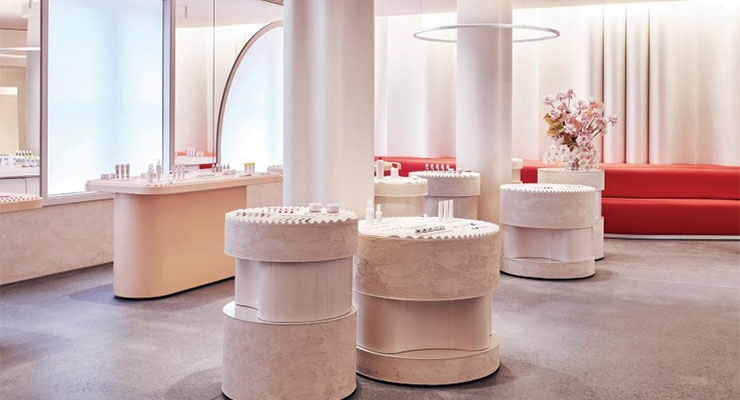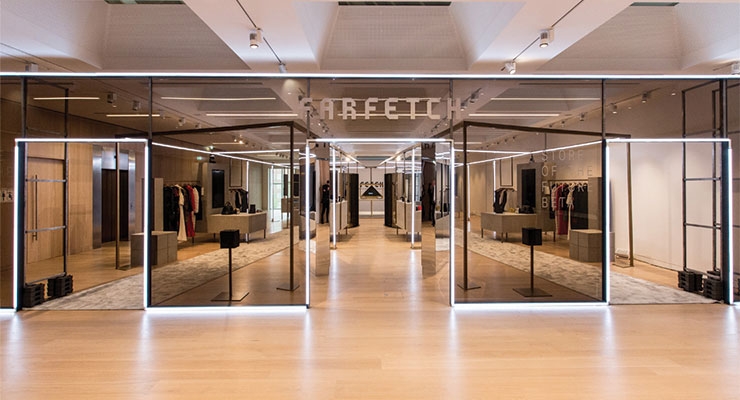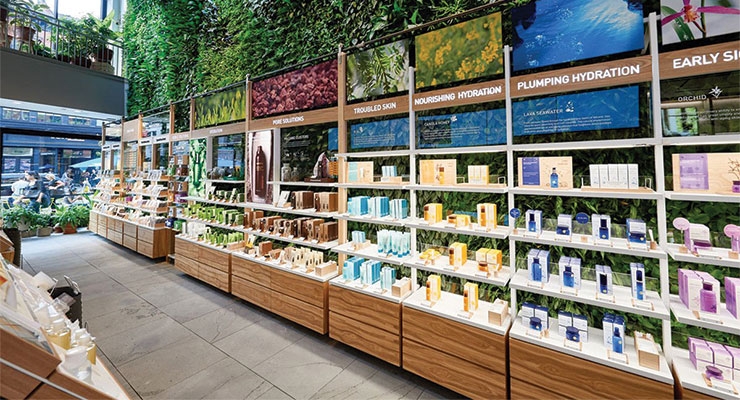Elle Morris and Jennifer Murtell, CEO and Vice President, Strategy, Snapdragon02.05.20
The beauty business historically remains resilient, despite economic conditions. According to the “Lipstick Effect,” a theory proposed by Juliet Shor in The Over-Spent American, when budgets are tight, women turn to low-investment purchases that make them feel special, luxurious and confident. So, with this evergreen opportunity, what might the beauty retail landscape look like in five years? In 10 years?
Digital Natives Drive Holistic Experiences
The purchasing power of Millennials and Digital Natives has driven the consumer landscape into much deeper and more immersive brand experiences, across many categories, and beauty is no exception. These consumers have an expectation of being wowed, and immersing them means creating brand worlds that envelop them in a holistic experience—seamless from beginning to end.
Glossier, positioned as a technology brand, has an undisputed cult following with a relatively focused product range—40 simple SKUs, grounded in skincare, with extensions into natural-look cosmetics and fragrances. Glossier’s core brand pillar is one of natural beauty, gently defying the highly painted and sculp’tured look of competitors. With their roots in content-forward engagement, they maintain a massive presence online; their Into the Gloss blog, has helped the brand make inroads to two-way conversations with consumers.
Glossier has even moved into physical retail with a Soho flagship in New York City and Los Angeles’ Melrose Place, as well as various popup shops.
Two years ago, online retailer Farfetch launched, bridging the gap between the real and virtual shopping worlds. Founder José Neves envisioned a future retail destination, where technology had the power to unlock a more human, intuitive consumer experience. Their custom technology solution Connected Rail, a combination of RFID and ultrasound, recognizes both products removed from the rack, and the movement of the shopper, in real time. Products immediately appear on a large interactive screen in the store, and drop into shoppers’ consideration set in their mobile app. Immersing shoppers in 3-D holograms, touch-screen interactive mirrors in dressing rooms, and member sign-in stations, shoppers can try on, collect favorites, and assemble outfits seamlessly, blurring the lines between brick and mortar retail experiences and online engagement.
Data collected in both channels is used to build a more customized experience, pulling consumers into a seamless experience that harmonizes the most exciting, sensorial aspects of boutique experiences with the speed and convenience of online shopping.
Expect to see this kind of seamless technology emerging in the beauty space, where opportunities for personal connection, customization, and transformation are the most dramatic. Charlotte Tilbury is already using smart mirrors for virtual makeovers and cosmetic trials.
Mashup Experientialism
Lifestyle brands can’t be created with algorithms; they must both drive, and respond to, the current cultural zeitgeist. It’s this give-and-take relationship with the broader culture that can prove rewarding for brands that are paying attention to not just their world, but the complex, nuanced and ever-changing world of their consumers.
One of the fastest-growing brands in the Amorepacific portfolio, Innisfree is responsive to the shifting interest and attention of the beauty consumer with nimble innovation, endlessly customizable regimens and engaging environments. Known for fresh formulas and committed green practices, all products contain 80% naturally-derived ingredients, responsibly sourced from the pristine Korean island of Jeju. Their NY boutique wraps shoppers in a feast for the senses; housed on two floors, the main floor engages shoppers in what feels like a Zen produce market experience, while the mezzanine houses makeup artist classes, and Korean skin regimen training and classes on greener living. The space teems with life, featuring a soaring living green wall that teleports shoppers to the brand’s Jeju Island and its green tea fields. This immersive experience embodies an oasis in the city for a truly immersive, sensory brand experience.
Showrooming: Brand Experience, No Purchase Required
More and more customers are using brick and mortar stores as places to discover and engage with products, but they don’t necessarily buy in-store. Conversely, 48% of customers say they use mobile apps to help them when shopping while in-store. Consequently, retailers are responding to this shift in hybrid purchasing behaviors by exploring the idea of ‘showrooming,’ a fresh use of conventional retail space that prioritizes creating robust brand experiences and deepening relationships with consumers over making the sale.
Samsung opened the doors of its long-awaited, 55,000-foot “technology playground and cultural destination,” in 2016 in New York City’s Meatpacking district, dubbed 837. You can’t purchase a single Samsung product at 837, but you can get a beautiful espresso.
Samsung describes 837 as the ‘physical manifestation of the company’s brand,’ and the result is sleek, engaged, multifaceted, and showy. Samsung hosts a variety of events in the space, like innovation workshops, fashion events, and screenings. But the day-to-day experience at 837 is also impressive, and includes VR chairs, high-tech selfie stations, a recording studio, a technology concierge for expert advice, and a real-time, ever-changing personalized Instagram tunnel.
Positioned as ‘your friendly neighborhood service hub,’ the Nordstrom Local experiment is living and thriving in New York and Los Angeles, despite a slow start.
Their merchandise-free boutique storefronts offer shoppers a unique service-first point of view, with personal stylists, manicures, alterations, a juice and espresso bar, gift-wrapping, and last but not least, online purchase pickup and returns. Nordstrom Local runs on their historical mythology, an embodiment of the brand’s epic heritage in supreme customer service. Local locations even take donations of “gently-used fashion” for charity. They also encourage their “neighbors” to use Local as a meeting spot for networking and family-driven events.
Timeless Principles, Future-Facing Opportunities
Experiential retail branding isn’t about spending millions on edgy devices. Technology is certainly a relevant platform with potential for longer-term return, but ultimately, it’s a tool, not a strategy. Creating rich brand experiences is about listening to people, having your finger on the pulse of culture, and amplifying what your brand stands for. Consumer desire hasn’t changed, but the tools, methods and mediums we leverage to meet their desire have. Creating an immersive, personalized shopping experience that embodies and activates the essence of your brand can create an unparalleled experience for loyal customers, and inspire loyalty in those who were previously uncommitted. Here are a few guiding principles:
Immerse the Senses: Leverage attention to sensorial detail, ensuring that your brand experiences are holistic, and actually connect all sensory experiences to one another. Memories are powerfully triggered by our senses: what we feel, hear, see, smell and touch are cognitively impactful, and can last a lifetime.
Be an Original: Does your brand have a unique perspective to offer the world? Leveraging the core pillars of your brand is the basis for creating authentic worlds for consumers to explore. When brands create spaces that reflect their true fundamental nature, consumers can’t help but be enchanted.
Build Connection: We all know that consumers don’t just choose brands, they build relationships. Create engagement that makes consumers feel special, regardless of channel or touch point. Make them feel that the experience has been created for them, with tools and options that strike a balance between self-curation and guidance.
Be Surprising: Provide opportunities for consumers to engage their curiosity; let them explore, discover and uncover something truly unexpected. Surprise and delight go a long way to create memorable engagements that stick. Think about what is truly unexpected about your brand; what contradictions does the brand embrace? What kind of energy does your brand exude, and how might you harness it in a brand interaction?
Be Consistent: The experience must be executed holistically and consistently, to build trust. We all know that powerful brands speak in a single, unified voice, but with the seemingly countless touchpoint and engagement opportunities available, creating a holistic brand presence that can unpack diverse and multifaceted experiences requires more discipline and focus than ever.
www.wearesnapdragon.com
About the authors:
Elenita (Elle) Morris is president & CEO of SnapDragon, a female-owned and led global brand design consultancy.
Jennifer Murtell is vice president of strategy at SnapDragon.
Digital Natives Drive Holistic Experiences
The purchasing power of Millennials and Digital Natives has driven the consumer landscape into much deeper and more immersive brand experiences, across many categories, and beauty is no exception. These consumers have an expectation of being wowed, and immersing them means creating brand worlds that envelop them in a holistic experience—seamless from beginning to end.
Glossier, positioned as a technology brand, has an undisputed cult following with a relatively focused product range—40 simple SKUs, grounded in skincare, with extensions into natural-look cosmetics and fragrances. Glossier’s core brand pillar is one of natural beauty, gently defying the highly painted and sculp’tured look of competitors. With their roots in content-forward engagement, they maintain a massive presence online; their Into the Gloss blog, has helped the brand make inroads to two-way conversations with consumers.
Glossier has even moved into physical retail with a Soho flagship in New York City and Los Angeles’ Melrose Place, as well as various popup shops.
Two years ago, online retailer Farfetch launched, bridging the gap between the real and virtual shopping worlds. Founder José Neves envisioned a future retail destination, where technology had the power to unlock a more human, intuitive consumer experience. Their custom technology solution Connected Rail, a combination of RFID and ultrasound, recognizes both products removed from the rack, and the movement of the shopper, in real time. Products immediately appear on a large interactive screen in the store, and drop into shoppers’ consideration set in their mobile app. Immersing shoppers in 3-D holograms, touch-screen interactive mirrors in dressing rooms, and member sign-in stations, shoppers can try on, collect favorites, and assemble outfits seamlessly, blurring the lines between brick and mortar retail experiences and online engagement.
Data collected in both channels is used to build a more customized experience, pulling consumers into a seamless experience that harmonizes the most exciting, sensorial aspects of boutique experiences with the speed and convenience of online shopping.
Expect to see this kind of seamless technology emerging in the beauty space, where opportunities for personal connection, customization, and transformation are the most dramatic. Charlotte Tilbury is already using smart mirrors for virtual makeovers and cosmetic trials.
Mashup Experientialism
Lifestyle brands can’t be created with algorithms; they must both drive, and respond to, the current cultural zeitgeist. It’s this give-and-take relationship with the broader culture that can prove rewarding for brands that are paying attention to not just their world, but the complex, nuanced and ever-changing world of their consumers.
One of the fastest-growing brands in the Amorepacific portfolio, Innisfree is responsive to the shifting interest and attention of the beauty consumer with nimble innovation, endlessly customizable regimens and engaging environments. Known for fresh formulas and committed green practices, all products contain 80% naturally-derived ingredients, responsibly sourced from the pristine Korean island of Jeju. Their NY boutique wraps shoppers in a feast for the senses; housed on two floors, the main floor engages shoppers in what feels like a Zen produce market experience, while the mezzanine houses makeup artist classes, and Korean skin regimen training and classes on greener living. The space teems with life, featuring a soaring living green wall that teleports shoppers to the brand’s Jeju Island and its green tea fields. This immersive experience embodies an oasis in the city for a truly immersive, sensory brand experience.
Showrooming: Brand Experience, No Purchase Required
More and more customers are using brick and mortar stores as places to discover and engage with products, but they don’t necessarily buy in-store. Conversely, 48% of customers say they use mobile apps to help them when shopping while in-store. Consequently, retailers are responding to this shift in hybrid purchasing behaviors by exploring the idea of ‘showrooming,’ a fresh use of conventional retail space that prioritizes creating robust brand experiences and deepening relationships with consumers over making the sale.
Samsung opened the doors of its long-awaited, 55,000-foot “technology playground and cultural destination,” in 2016 in New York City’s Meatpacking district, dubbed 837. You can’t purchase a single Samsung product at 837, but you can get a beautiful espresso.
Samsung describes 837 as the ‘physical manifestation of the company’s brand,’ and the result is sleek, engaged, multifaceted, and showy. Samsung hosts a variety of events in the space, like innovation workshops, fashion events, and screenings. But the day-to-day experience at 837 is also impressive, and includes VR chairs, high-tech selfie stations, a recording studio, a technology concierge for expert advice, and a real-time, ever-changing personalized Instagram tunnel.
Positioned as ‘your friendly neighborhood service hub,’ the Nordstrom Local experiment is living and thriving in New York and Los Angeles, despite a slow start.
Their merchandise-free boutique storefronts offer shoppers a unique service-first point of view, with personal stylists, manicures, alterations, a juice and espresso bar, gift-wrapping, and last but not least, online purchase pickup and returns. Nordstrom Local runs on their historical mythology, an embodiment of the brand’s epic heritage in supreme customer service. Local locations even take donations of “gently-used fashion” for charity. They also encourage their “neighbors” to use Local as a meeting spot for networking and family-driven events.
Timeless Principles, Future-Facing Opportunities
Experiential retail branding isn’t about spending millions on edgy devices. Technology is certainly a relevant platform with potential for longer-term return, but ultimately, it’s a tool, not a strategy. Creating rich brand experiences is about listening to people, having your finger on the pulse of culture, and amplifying what your brand stands for. Consumer desire hasn’t changed, but the tools, methods and mediums we leverage to meet their desire have. Creating an immersive, personalized shopping experience that embodies and activates the essence of your brand can create an unparalleled experience for loyal customers, and inspire loyalty in those who were previously uncommitted. Here are a few guiding principles:
Immerse the Senses: Leverage attention to sensorial detail, ensuring that your brand experiences are holistic, and actually connect all sensory experiences to one another. Memories are powerfully triggered by our senses: what we feel, hear, see, smell and touch are cognitively impactful, and can last a lifetime.
Be an Original: Does your brand have a unique perspective to offer the world? Leveraging the core pillars of your brand is the basis for creating authentic worlds for consumers to explore. When brands create spaces that reflect their true fundamental nature, consumers can’t help but be enchanted.
Build Connection: We all know that consumers don’t just choose brands, they build relationships. Create engagement that makes consumers feel special, regardless of channel or touch point. Make them feel that the experience has been created for them, with tools and options that strike a balance between self-curation and guidance.
Be Surprising: Provide opportunities for consumers to engage their curiosity; let them explore, discover and uncover something truly unexpected. Surprise and delight go a long way to create memorable engagements that stick. Think about what is truly unexpected about your brand; what contradictions does the brand embrace? What kind of energy does your brand exude, and how might you harness it in a brand interaction?
Be Consistent: The experience must be executed holistically and consistently, to build trust. We all know that powerful brands speak in a single, unified voice, but with the seemingly countless touchpoint and engagement opportunities available, creating a holistic brand presence that can unpack diverse and multifaceted experiences requires more discipline and focus than ever.
www.wearesnapdragon.com
About the authors:
Elenita (Elle) Morris is president & CEO of SnapDragon, a female-owned and led global brand design consultancy.
Jennifer Murtell is vice president of strategy at SnapDragon.

































